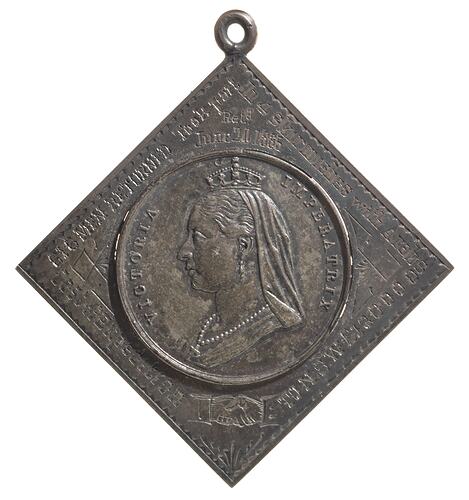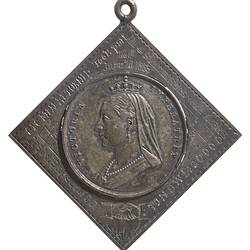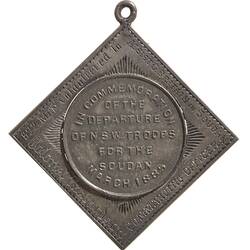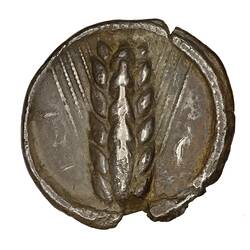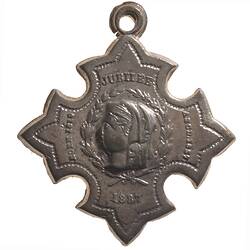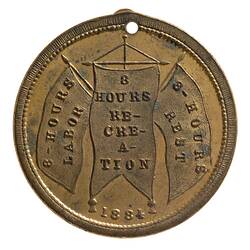Summary
Australia New South Wales Sydney
Departure of the Troops for Soudan 1885 (AD)
Mint: not recorded
Other Details: Medals issued to commemorate the return of troops from Soudan. It was made to help raise money for a Patriotic Fund. Australia's first expeditionary force, which fought in the Soudan, arrived back in Sydney on 19 June 1885. It had been led by Colonel John Soame Richardson, named on the medal. Five days later the contingent marched through the city to a reception at Victoria Barracks where they stood in pouring rain as the Governor, Lord Loftus, and the Premier gave speeches. It was generally agreed that, no matter how insignificant the military contribution by New South Wales, it marked an important stage in the development of colonial self-confidence and demonstrated the important of links with Britain.
Previous Collections: George McArthur
Obverse Description
Bust of Queen Victoria veiled and wearing small crown, facing right; around, VICTORIA IMPERATRIX Engraved on mount; 616 MEN RETURNED TOOK PART IN 4 SKIRMISH ES WITH ARABS/COST OF EXPEDITION TO NSW 130,000/RETD/JUNE 20 1885 Hands shaking engraved at base of mount
Reverse Description
Legend on struck medal : IN COMMEMORATION / OF THE / DEPARTURE / OF N.S.W. / TROOPS / FOR THE / SOUDAN / MARCH 1885 Around, engraved on mount, 622 MEN VOLUNTEEREDTO ASSIST G. BRITAININ SOUDAN Colonel Richardson COMMANDING OFFICER
Edge Description
Plain
Significance
In the early 1880s the British-backed Egyptian regime in the Sudan was threatened by a local rebellion led by Muhammed Ahmed, known to his followers as the Mahdi. In 1883 the Egyptian government sent an army south to crush the revolt. The Egyptians were soundly defeated, leaving their government with the problem of extricating the survivors. The British were persuaded to send General Charles Gordon, already heroic figure throughout the Empire, to determine a method by which the Egyptian troops could be safely withdrawn.
Gordon's enthusiasm for the task ran away with him, and instead of evacuating the troops he attacked the Mahdi. He soon found himself besieged in Khartoum. The English public was horrified by the predicament of the popular general, and a relief force was sent to Cairo in September 1884. It met stiff resistance and was still fighting its way up the Nile when Gordon was killed four months later. When word of his death was received in New South Wales loud recriminations were expressed against the Liberal government for having failed to act.
The Canadian government leapt into action and offered to send troops to the Sudan. Not to be outdone, the NSW government cabled London with its own offer, promising to meet the contingent's expenses. Britain accepted, but insisted that the contingent would be under British command. The news was received with great enthusiasm in New South Wales, marking the first time that soldiers in the pay of a self-governing Australian colony would fight in an imperial war.
On 3 March 1885 an infantry battalion of 522 men and 24 officers, and an artillery battery of 212 men, set sail. A public holiday was held to mark the occasion, described as the most festive ever seen in Sydney. Many people were hostile to the war, however, particularly in working-class suburbs and rural areas.
Twenty-six days later the contingent anchored at Suakin, Sudan's Red Sea port, and were attached to a brigade composed of Scots, Grenadiers and Coldstream Guards. They were immediately ordered to march in formation to Tamai, a village some 30 kilometres inland. The infantry reached Tamai almost without incident, burned some huts and returned to Suakin.
After Tamai, most of the NSW contingent worked on the railway line being laid across the desert towards the inland town of Berber on the Nile, half-way between Suakin and Khartoum. The artillery saw even less action than the infantry. They were posted to Handoub where they drilled for a month, then rejoined the camp at Suakin. Meanwhile the British government had decided to abandon the campaign, leaving only a single garrison in Suakin. The Australian contingent sailed for home on 17 May 1885, a mere 50 days after they had arrived. Australian casualties were few, and those who died fell to disease rather than enemy action.
The contingent arrived in Sydney on 19 June. Five days later the contingent marched through the city to a reception at Victoria Barracks where they stood in pouring rain as the Governor, Lord Loftus, and the Premier gave speeches. It was generally agreed that, no matter how insignificant the military contribution by New South Wales, it marked an important stage in the development of colonial self-confidence and demonstrated the important of links with Britain.
-Australian War Memorial web site http://www.awm.gov.au/atwar/sudan.htm.
-D. Tout-Smith 25/9/2003.
More Information
-
Collection Names
-
Collecting Areas
-
Acquisition Information
Transfer from National Gallery of Victoria (NGV), George McArthur, 15 Mar 1976
-
Date Issued
1885 AD
-
Issued By
-
Person Named
-
Person Depicted
-
Previous Collection
-
Inscriptions
Plain (edge) VICTORIA IMPERATRIX (Engraved 616 MEN RETURNED TOOK PART IN 4 SKIRMISH ES WITH ARABS/COST OF EXPEDITION TO NSW 130,000/RETD/JUNE 20 1885 (obverse) IN COMMEMORATION/OF THE/DEPARTURE/OF N.S.W. TROOPS/FOR THE/SOUDAN/ MARCH 1885 (reverse)
-
Series
-
Material
Silver
-
Axis
12
-
Classification
-
Category
-
Discipline
-
Type of item
-
Shape
Diamond with loop
-
References
Car 1885/1
[Thesis] Lugton, Mary E. 1989. George McArthur of Maldon: his Life and his Book Collection.
[Catalogue] Morrison, Ian. 2003. The Baker of Maldon.
-
Keywords
